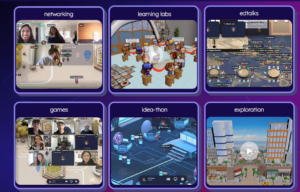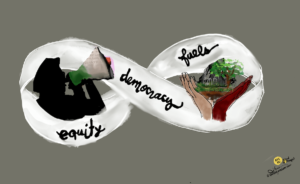An Equal Opportunity to Participate in the Future

“This country will never redistribute wealth,” said Chris Romer, “But we will redistribute opportunity.” Romer, a former Colorado State Senator and President of HigherEd startup American Honors, was addressing the growing gap between top quartile and bottom quartile.
Romer and 100 other education CEOs gathered at the invitation of GSV’s Michael Moe (@GSVcap) and Deborah Quazzo (@GSVedu, @Quazzo). The goal of the summit was to discuss how we could “Ensure that every person in the country (and eventually the planet) has an equal opportunity to participate in the future.”
The small group shared big dreams of impact. Typical of the CEOs, Romer encourages American Honors scholars to embrace, “A dream big enough to scare you.” Romer’s dream is to serve 30,000 low-income students in affordable degree pathways.
Moe-mentum. Describing the automation of work, Moe said, “One job after another is getting Siri-ed.” Factories are being automated and apps like Uber are empowering users.
Moe described the old model: Play from age 0 to 4, learn from 5 to 19, work from 20 to 65, and retire. The new model is learn–birth to grave. “The old ticket was a diploma, said Moe, “The new ticket is competency.”
Despite rapid growth of investment in the last few years, Moe noted that the top 10 public companies serving education are only worth $50 billion—Disney is worth three times as much by itself, Google is worth six times as much. We’re early in a learning revolution and “equal opportunity” will require billions more in investment and dozens of scaled impact-focused organizations.
Modern civilization is characterized by hyperconnectivity–computing costs approaching zero, the app economy, and declining privacy– and the drive for progress—producing a global middle class of 5 billion by 2030. Moe suggests the equation for this connected world is true ideas + good values.
Of the three options to drive change—coercion, incentives, and inspiration—the best option in the connected world, according to Moe, is inspiration. As Michael Fullan said, “Change really isn’t as hard as we thought if we capture people’s interest and give them enjoyable, worthwhile experiences.”
Remarkable. Team GSV created a useful framework for dialog connecting innovation and equity, execution and excellence, scale and access. There were ten remarkable conversation threads:
- Competency. Personalized and competency-based learning–elementary to job training—were frequently discussed. In a breakout session, Elijah Mayfield, TurnItIn, summarized four breakthrough categories: competency (i.e., high agency show what you know tools), tools that enable network effects, adequate and portable resources, and a reduction of incumbency effects (i.e., trapped in status quo land).
- Equity. Despite all the return-seeking companies represented, educators like Shawn Jackson, Chicago Public Schools, and local Eagle County superintendent, Jason Glass were pleased to see the focus on equity and impact in every segment.
- Ecosystem. The Chicago EdTech ecosystem is hot—and it was well represented. In addition to Deb Quazzo, there was Heather Anichini, Chicago Fund; Phyllis Lockett, LEAP innovation; Eileen Murphy, ThinkCerca, and Daniel Hamburger, DeVry.
- Collaboration. Former high school principal and Colorado Senator Mike Johnston urged collaboration when it comes to innovations in learning and, “Less score keeping and more progress tracking.” The moral of Mike’s stories is every student matters.
- Exceptionality. The potential of meeting exceptional needs was expressed by Clay Whitehead, PresenceLearning, and Jessie Woolley-Wilson, Dreambox Learning.
- Cool Schools. Corey Scholes, Kauffman Foundation, introduced Senator Johnston because she was his Expeditionary Learning coach. She described the Ewing Marion Kauffman School, a mashup of Uncommon and EL (it sounds like a Joy & Rigor blend).
- Books. Despite a drop in adult print book sales, digital advocate Alex Hernandez, Charter Growth Fund, found the growth of print books for young readers a promising development in saying, “It’s a good UI for little kids.” David Roland, Ingram, said, “It will always be mixed mode, kids love books.”
- HigherEd. Ben Nelson and Miriam Rivera, Minerva; Burck Smith, Straighterline; David Blake, Degreed; and George Straschnov, Bisk, and Chip Paucek, 2U were among the leaders discussing the potential for excellent and affordable higher learning.
- Investing. Both venture and philanthropic, in addition to the GSV team there were great investors sharing tips including Brian Greenberg, SiliconSchools; Rick Segal, Rethink, and Jason Stoffer, Maveron.
- March to Impact. Jim Collins led a thought provoking half day discussion (but more on that later).
The remarkable thing about the gathering was spending two days with more than 100 people that believe as strongly as I do that innovations in learning can improve life on planet earth for the 7 billion people we share it with.
For more on GSV, see:






Tim Holt
This is tacit confirmation that the old adage of "Equal Opportunity for all" that every kids has been told since time in memoriam is incorrect, and frankly a lie. (The Right had better think of a new slogan to blame poor people for their lack of money.) If you only work hard you will succeed has been the mantra of the white upper class for ever. Are we now ready to admit that that is wrong and that we have been lied to all of these years?
If we have to rethink the way we "distribute opportunity" than that means that opportunity is not distributed either equally or fairly.
Who's fault is that? Surely not those that do not have access to those opportunities. I suggest that it is because the wealthy basically do not what everyone playing in their sandbox, nor do I think that they will be willing to let too many in.
If Romer is correct and "This country will never redistribute wealth" then that means that the rich will always be rich and the poor always will be poor. With wealth comes opportunity, despite what a few billionaires want us to believe. If I can't afford to buy my kid a computer and internet access when they are little kids, they automatically are behind their peers at higher SES status.
Saying that opportunity will be there and anyone can access it is akin to saying "Here is a big football stadium and everyone can play in it. However, some of you will have to climb the fence to get in and will have to provide your own uniforms and coaches, and some of you will be delivered inside via air conditioned bus, have your uniforms tailor made of you, and have the best coaches we can buy."
Yeah, the OPPORTUNITY is there, but getting the opportunity is still different for different groups.
Replies
Tom Vander Ark
Great schools for all families is an important goal--and the opportunity to fulfill that goal in this country and worldwide gets better every month. There is no one that cares more about equitable distribution of opportunity than Chris Romer (or his dad, Gov. Roy Romer). His comment reflected frustration with the realities of American politics but optimism about the improving ability to create great educational pathways for every young person.